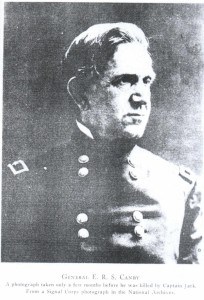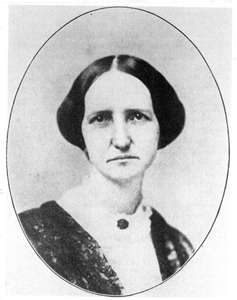Off Wabash Avenue on the east side of Crawfordsville is Canby Avenue. It is one of the few local reminders of E.R.S. Canby, a local boy, friend of Lew Wallace, and one of Crawfordsville’s five Civil War generals. The Canby family settled in Crawfordsville in the 1830s and lived in a home that stood on the site of the old high school (now the Athena Center). Mr. Canby was in charge of the Federal Land Office. His son, Edward Richard Sprigg Canby (E.R.S.) grew up in Crawfordsville, attended Wabash College for one year, and then was appointed to West Point. Upon graduating from West Point, E.R.S. returned to Crawfordsville and married a local girl, Louisa (Lou) Hawkins.
E.R.S. Canby’s Early Life
The Wallaces and the Canbys travelled in the same social circle and remained friends throughout their lives although their travels and careers often took the couples in different directions. Like the Lew and Susan Wallace, E.R.S. and Lou Canby had a strong marriage with each being a significant partner.

After graduating from West Point, Canby continued in military service seeing combat in Florida during the Second Seminole War in the late 1830s and early 1840s and in the Mexican-American War in the mid-1840s. Canby’s military service included posts in upstate New York, California, Wyoming, and Utah in the 1850s. By 1860, he was posted in New Mexico. Lou travelled to these postings with her husband and during these early years they had one child, Mary, who died young.
Canby in the Civil War
When the Civil War broke out, Canby remained out west. He was promoted to Colonel of the 19th U.S. Infantry on May 14, 1861. Less than a year later, he was promoted to Brigadier General in February of 1862. After some success in the west, particularly in Texas, Canby was posted to New York in the wake of the draft riots in 1863. Canby had a varied military career serving in both important administrative positions and active battle service.
Although Canby was a gifted administrator, there were some in the army, including General Grant, who thought he was not aggressive enough in the field. In May of 1864 he was promoted to Major General. Canby was posted to Louisiana for a time and then placed in command of the Military Division of Western Mississippi. He was wounded in November of 1864, but his wife nursed him back to health. When the Confederacy fell in April of 1865 he accepted the surrender of the Confederate forces west of the Mississippi. Immediately after the war, Canby was posted to Washington, D.C. where Grant came to hold Canby in great esteem for his knowledge and understanding of policy, law, and army regulations.
Like Lew Wallace, Canby’s family was divided during the War. At one time, his father had owned slaves and he had cousins who fought for the Confederacy. After the war other relatives became carpetbaggers in Louisiana where Canby had been posted as a military governor. These family members sought favors from Canby, who declined their requests for support.
After the Civil War
After the war he had a number of postings around the country including his service as military governor in Louisiana. This was followed by his appointment as Commander of the Fifth Military District, comprising the states of Delaware, Maryland, Alexandria and Fairfax, Virginia, and Washington, D.C. Many of these areas had been under the jurisdiction of Lew Wallace just a couple of years earlier. Additional postings in the Reconstruction South followed in Texas, North and South Carolina. Although he was seldom a favorite of either Republicans or Democrats, whites or blacks, state or federal officials, he conducted his business in fairness and honesty and was generally well respected.

In 1872, he was posted to the Pacific Northwest in the Oregon Territory in an effort by the U.S. government to address issues with the Modoc Indians. Relations between the Modoc tribe and the United States were tense after a series of failed negotiations and treaties over native lands. After a number of false starts, Canby was able to arrange a meeting with the leader of the Modoc tribe. Canby attended this meeting in April of 1873 unarmed, hopeful that he could relieve the building tension between the two sides. Although he understood the tension and knew that the Modoc were volatile, he arranged the meeting at a neutral site and went with a small group of men. During discussion when Canby indicated that he did not have the authority to grant the Modoc their ancestral lands, the leader of the Modoc tribe, Captain Jack, became enraged and attacked Canby. The general and the peace commissioner were killed and others in the party were injured.
There was a funeral service for Canby out west before the body was returned to Indianapolis for burial at Crown Hill. Civil War generals William Tecumseh Sherman, Phillip Sheridan, Irvin McDowell, and Lew Wallace were in attendance with McDowell and Wallace, his long-time friend, serving as pall bearers.
Louisa Hawkins Canby
Just as Susan Wallace would, at times follow her husband, Lew, during his postings during the Civil War, Mrs. Canby followed her general. Like Susan, Lou was also a woman who admired her husband, respected him, and helped him in many ways. Like Susan, Lou was also her own person. However, unlike Susan, some of Lou’s activities complicated her husband’s life. To his credit, when Lou was involved in controversy, Canby stood steadfast in his support of her.
Lou and Susan were good friends, but Lew’s relationship with Mrs. Canby went much farther back. When Lew’s mother died, his father had placed his three sons in the care of Louisa’s mother, Mrs. John Hawkins. The Wallace boys lived with the Hawkins family until their father married Zerelda.
The Canbys and Religion

Years earlier, Lou had demonstrated her openness with respect to religion. The Canbys followed William Tecumseh Sherman in a military posting in Monterey, California. Lieutenant Colonel Henry Stanton Burton, who was also posted in Monterey, caused a firestorm when he fell in love with Maria Amparo Ruiz, the granddaughter of the former governor of Baja, Mexico. The Roman Catholic Bishop of California condemned the marriage, as Burton was Protestant and Ruiz was Catholic. Because they were unable to marry in the church, Lou offered the Canby home for the ceremony, which took place on July 7, 1849. Canby was away on official business when Lou extended this offer. Upon his return, he was forced to publicly explain that his wife, a civilian, had acted alone and out of compassion.
Like Susan Wallace, Lou was a member of the Methodist Church. She was, however, a very forward thinking woman. At her husband’s funeral service in Portland she arranged for clergy from the three Protestant churches to conduct a joint service (a fourth clergyman bowed out) and at Crown Hill the service was conducted by both a Methodist and a Baptist minister.
Angel of Santa Fe
Both of the Canbys vigorously supported statehood for California in 1850. To help the cause Lou copied documents for the statehood convention and indexed Territorial records. Still out west when the Civil War broke out, the Canbys were stationed in New Mexico. While the Union troops were engaged in battle against the Confederates in distant parts of the territory, the cities of Albuquerque and Santa Fe fell to the southerners. Lou and several of the other officers’ wives made the bold decision to stay in Santa Fe instead of fleeing.
Although the confederates were soon forced out of Santa Fe, they left their sick and wounded behind. Winter was approaching and these men were left under-fed and ill housed. Lou went to visit these men and was so moved by their plight that she revealed a hidden store of blankets and food and turned her home into a hospital. She rounded up other wives to serve as nurses, went to outlying areas to bring the wounded Confederates in for care or treated them in situ if they couldn’t be moved. While she was given the name “the angel of Santa Fe” her actions were not without controversy. There were some who accused her of aiding and abetting the enemy by using Union supplies for wounded Confederates. Her actions also fed support to a whisper campaign against Canby, who had been born in Kentucky.
Louisa Alone
Lou continued to follow her husband wherever his military career took him. After his murder in 1872, the people of Portland rallied to her side. When they realized how small her widow’s pension would be, they raised $5,000 as a gift. While she accepted the money, she invested it and used only the interest generated. In her will, the full principal of $5,000 was returned to the people of Portland. She devoted the last sixteen years of her life to assuring that her husband would be remembered and was buried beside him in Crown Hill in 1889.
While she worked to keep the memory of her husband alive, Lou too was well remembered. In 1893, R.O. Fairs, a Confederate veteran, wrote the U.S. War Department looking to find Mrs. Canby. Not knowing that she had passed away in 1889, Fairs explained: “I wish to show her we still entertain kind remembrance and esteem for her, by inviting her to our reunion.”
It’s not surprising that the two generals and life-long friends are remembered. It is significant that Susan Wallace and Lou Canby, who also remained friends for life, are remembered not only as devoted wives to their military husbands, but also for their individual contributions, kind hearts, and personal achievements.
Sources
Erin Gobel – research
Journal Review, June 1962, information in the article provided by Robert F. Wernle
Wikipedia for E.R.S. Canby, Louisa H. Canby
Shadow of Shiloh by Gail Stephens
Lew Wallace An Autobiography by Lew (& Susan) Wallace
American History Illustrated, August 1978, Article, “The Modoc Indian War” by Dave Wilkinson
One thought on “The Wallaces and the Canbys”
Interesting story about the Cambys. Enjoyed reading it.